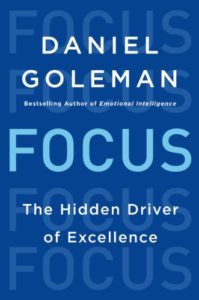
High-performers need three kinds of focus: inner, other, and outer – this is the big idea from “Focus: The Hidden Driver of Excellence” by Daniel Goleman. Inner focus is self-awareness – knowing and understanding yourself, seeing yourself realistically, seeing yourself as others see you. Other focus is seeing others and understanding where they are emotionally. The outer focus has two aspects – seeing what is going on around us and seeing what is happening in the future.
Self-awareness includes the ability to understand yourself, including seeing the underlying factors or causes of how you think and act. Included in here we can talk about the ability to focus our attention appropriately, which sometimes means to block out anything that interferes with a goal or task. At other times it is appropriate and productive to let our minds freely wander. In fact, this is often the source of innovation or invention and can sometimes be an important part of decision making.
Other focus includes the ability to read and properly react to the actions and emotions of others. It also includes social sensitivity which would cover the dynamics of groups and understanding cultural differences. Goleman talks here also about the empathy triad in which he differentiates between cognitive empathy, emotional empathy, and empathic concern. Cognitive empathy lets us take other people’s perspectives, comprehend their mental state, while at the same time managing our own emotions. With emotional empathy we join the other person in feeling along with them; our bodies resonate in whatever joy or sorrow that person may be going through. Empathic concern goes further, leading us to care about the other person, mobilizing us to help if need be.
Outer focus provides a view of the bigger picture. This includes the ability to see not just a certain discrete action but to comprehend the larger system or pattern. It also allows us to integrate widely diverse information to understand the potential interaction or affect somewhere else. In this respect, the ability to think further out in the dimension of time is another part of outer focus.
In these current times with the bombardment of information, Goleman warns against a decline in people’s ability to pay attention to a given thought for an extended time. In order to resolve big issues, we need to be able to think them through thoroughly. The information age and all of our electronic devices are creating habits of bouncing from one piece of information to another. There are times in our lives when we want to scan broadly but there remain times that we need to focus.
Goleman spends some time talking about mindfulness, studies of neuroscience, and practices to increase our ability to focus in various dimensions. The downside of the book is the amount of time spent on what could be considered the author’s social rants.
All in all, a good read with some interesting perspectives but not a must read. I give it a B- or a 6 out of 10.
“… a failure to focus inward leaves you rudderless, a failure to focus on others renders you clueless, and a failure to focus outward may leave you blindsided.” – Daniel Goleman

Add your comment